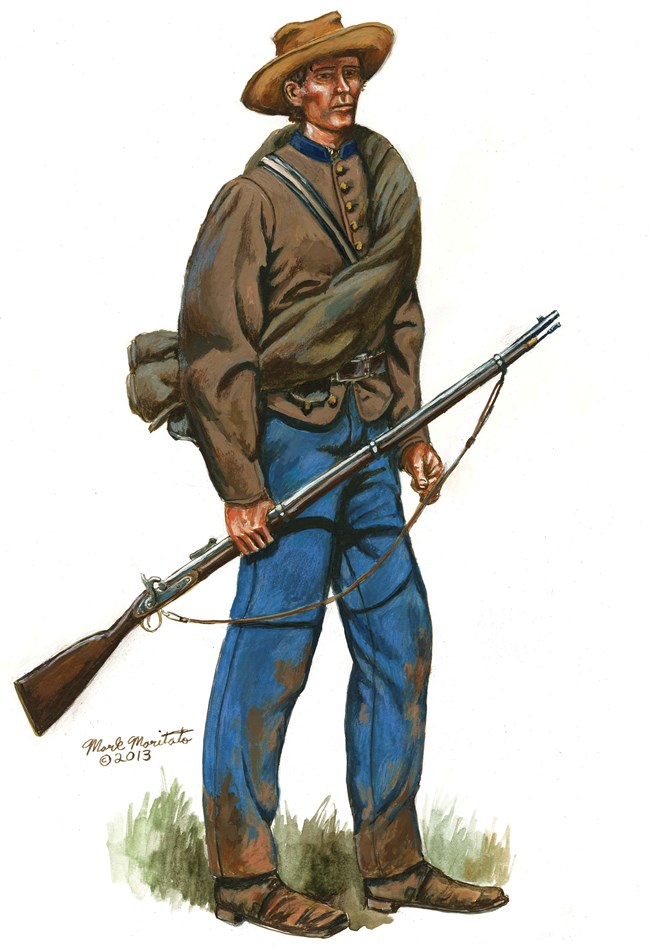Part of a series of articles titled From Backcountry to Breadbasket to Battlefield and Beyond.
Previous: Vital Route
Next: Faces of the Valley
Article

Library of Congress
“This is the most painful vote I ever gave. The course of the Administration, making actual war upon the South…seemed to leave no alternative. I mourn in bitterness the state of things.”
Francis McFarland, 1861
The Shenandoah Valley’s geological formation created a natural corridor, which during the Civil War attracted armies on both sides as an avenue of invasion and counter-invasion. As war loomed, tensions in the Valley increased over fundamental rights and freedoms — political loyalties became bitterly strained. It was enough to tear Virginia apart.
The Shenandoah Valley was well-known throughout the country as a premier wheat producing region. Large numbers of Scots-Irish and German families worked diversified, small family farms to cultivate wheat as well as a range of other crops. Although the exception, pockets of plantation culture including large numbers of slaves, existed in parts of the Valley. Yet slavery spread slowly and few owned slaves. As a result, the Valley had a culture based on both Northern and Southern values.
Tensions between eastern and western Virginia grew in the decades leading up to the Civil War. Those in the western portion of the state wanted more equitable representation as well as public works, especially roads and railroads. The state government, dominated by eastern interests, seemed unconcerned with issues raised by these farmers and “plain people.”Into this turbulent political setting came a test of loyalties and talk of war. In 1861, Virginians had to decide for or against secession. Although most Valley residents favored remaining in the Union, once Abraham Lincoln’s call for troops against the seceded Southern states came, people opted to support their state and the Confederacy. This outcome did little to reduce tensions in the west. In short order the western counties created a new state, splitting Virginia in two. Most of the Shenandoah Valley remained loyal to the Confederacy.

NPS
The typical infantryman carried a variety of equipment and weapons, including a knapsack (backpack) for personal items and extra clothing, blanket, canteen, haversack (for food and eating utensils), tin cup, cartridge box, cap box (on his belt), bayonet and rifle. The combined weight could exceed 50 pounds.This soldier carried a Model 1853 Enfield rifle-musket (not shown), a single-shot weapon that fired a .577 caliber bullet to an effective range of 500 yards. A soldier was supposed to be able to load and fire his rifle three times a minute.

NPS
The Shenandoah Valley became a major theater of operations from 1861-1865, witnessing hundreds of skirmishes and engagements, including twenty battles.
The soldiers who fought in the Valley, both Union and Confederate, represented the wide cross-section of American society. Nearly all saw themselves as citizen-soldiers fighting for similar causes (their idea of American democracy and freedom, defense of their “country” and defense of homes and loved ones). Many of the Confederate soldiers who served in the Shenandoah throughout the war, were actually natives of the Valley. Thus, in some cases, these men were actually defending their childhood homes and towns.

NPS
First Battle of Kernstown - Union Victory
Battle of McDowell - Confederate Victory
First Battle of Winchester - Confederate Victory
Battle of Cross Keys - Confederate Victory
Battle of Port Republic - Confederate Victory
Second Battle of Winchester - Confederate Victory
Battle of New Market - Confederate Victory
Battle of Piedmont - Union Victory
Hunter sacks Lexington, burns Virginia Military Institute
Battle of Lynchburg - Confederate Victory
Early's Raid on Washington, DC and the Battle of Monocacy Confederate Victory on July 9
Battle of Second Kernstown - Confederate Victory
Burning of Chambersburg - Early's cavalry destroys the town in retaliation for the burning of Virginia Military Institute
Philip Sheridan assumes command of the Army of the Shenandoah
Third Battle of Winchester - Union Victory
Battle of Fishers Hill - Union Victory
The Burning - Sheridan orders the destruction of a 75-mile swath of the Valley
Battle of Tom's Brook - Union Victory
Skirmish on Hupp's Hill
Sheridan leaves for Washington, DC
Confederate officers create an attack plan against the Union army.
Battle of Cedar Creek - Union Victory
Part of a series of articles titled From Backcountry to Breadbasket to Battlefield and Beyond.
Previous: Vital Route
Next: Faces of the Valley
Last updated: June 28, 2022